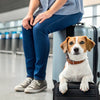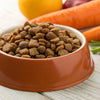When to Give Dog Water After Exercise: Essential Hydration Tips for Pet Owners
- Houndsy
Table of Contents
- Introduction
- The Importance of Hydration for Dogs
- Signs That Your Dog May Need Water
- Best Practices for Offering Water After Exercise
- How to Encourage Your Dog to Drink More Water
- The Role of the Houndsy Kibble Dispenser
- Conclusion
- FAQ
Introduction
Have you ever watched your dog sprint around the park, tail wagging with joy, only to notice them panting heavily afterward? This scene is all too familiar for many dog owners, and it raises an important question: When should we give our dogs water after exercise? Hydration is crucial for our furry friends, especially after they’ve expended energy running, playing, or engaging in any kind of physical activity.
As we dive into this topic, we'll explore why proper hydration is essential, how to recognize signs of dehydration, and the best practices for offering water to your dog post-exercise. By the end of this blog, you’ll be equipped with valuable insights that will enhance your pet care routine and ensure your four-legged friend stays healthy and happy.
In this article, we will cover:
- The importance of hydration for dogs
- Signs that your dog may need water
- Best practices for offering water after exercise
- How to encourage your dog to drink more water
- The role of the Houndsy Kibble Dispenser in your dog’s feeding and hydration routine
Let’s embark on this journey to ensure our pets are well-hydrated and ready to enjoy their next adventure!
The Importance of Hydration for Dogs
Just like us, dogs rely on water to maintain their health and well-being. Water plays several critical roles in a dog's body, including:
- Regulating Body Temperature: Dogs primarily cool off by panting, which releases heat. Proper hydration helps maintain their body temperature during and after exercise.
- Supporting Digestion and Nutrient Absorption: Water aids in breaking down food, allowing nutrients to be absorbed effectively.
- Joint Lubrication: Adequate hydration keeps your dog’s joints lubricated, which is essential for maintaining mobility and preventing injuries.
- Preventing Dehydration: Dehydration can lead to severe health issues, including organ failure. Dogs can lose water through panting, urination, and defecation, making it crucial to replenish their fluids, especially after exercise.
How Much Water Should a Dog Drink?
On average, a dog should drink about 1 ounce of water per pound of body weight per day. For instance, a 50-pound dog would typically require 50 ounces of water daily. However, this can vary based on factors like:
- Activity Level: Active dogs require more water.
- Temperature: Hot weather increases hydration needs.
- Diet: Dogs that consume dry kibble may need more water than those on a wet food diet.
Having this knowledge helps us understand the importance of monitoring our pets' hydration levels, especially after exercise.
Signs That Your Dog May Need Water
Recognizing when your dog is thirsty is essential for their health. Here are some signs that indicate your furry friend might need hydration:
- Panting and Heavy Breathing: If your dog is panting excessively after exercise, it's a clear sign they may need water.
- Dry Nose and Gums: A dry or sticky mouth can indicate dehydration. Check your dog’s gums; they should be moist and pink.
- Lethargy: If your dog seems unusually tired or unwilling to play, they might be dehydrated.
- Loss of Skin Elasticity: Gently pinch the skin on the back of your dog’s neck. If it doesn't return to its normal position quickly, they could be dehydrated.
- Dark Urine: If your dog's urine is darker than usual, it may indicate they need more fluids.
The Importance of Timing
One of the most valuable things we can do as pet owners is to understand the timing of hydration after exercise. While it’s important to offer water immediately after physical activity, we must also be cautious about how much they drink at once.
Best Practices for Offering Water After Exercise
When it comes to providing water to our dogs after exercise, there are several best practices to keep in mind:
- Allow for a Cool Down: Instead of rushing directly to the water bowl, give your dog a few minutes to cool down. This helps prevent potential stomach upset from drinking too quickly.
- Offer Small Amounts: Instead of letting your dog gulp down a large bowl of water, offer small amounts at a time. This can help prevent bloating and discomfort.
- Use a Portable Water Bottle: If you're out and about, consider using a portable dog water bottle or collapsible bowl. This makes it easy to provide hydration on the go and encourages your dog to drink more frequently.
- Monitor Their Intake: Keep an eye on how much water your dog consumes after exercise. If they seem uninterested or hesitant to drink, try offering flavored water, such as adding a splash of low-sodium chicken broth.
- Create a Routine: Establishing a hydration routine reinforces the importance of drinking after exercise. For example, take your dog for a walk, then offer water immediately upon returning home.
How to Encourage Your Dog to Drink More Water
For some dogs, drinking enough water can be a challenge. Here are some creative ways to encourage your pet to stay hydrated:
- Add Flavor: As mentioned earlier, adding broth or a splash of tuna water can make drinking more appealing to dogs.
- Use a Pet Fountain: Dogs often prefer fresh, flowing water. A pet fountain can encourage them to drink more due to the movement of the water.
- Freeze Treats: Create frozen treats by mixing water with your dog’s favorite flavors. These can be refreshing and enticing, especially on a warm day.
- Hydration Stations: Place water bowls in various areas of your home. This ensures your dog always has access to fresh water and encourages them to drink more frequently.
The Role of the Houndsy Kibble Dispenser
At Houndsy, we always prioritize the convenience and well-being of both pets and their owners. Our flagship product, the Houndsy Kibble Dispenser, not only makes feeding easier but can also play a role in your dog's hydration routine.
Features of the Houndsy Kibble Dispenser
- Perfect Portion Control: Our dispenser delivers the perfect amount of kibble every time, ensuring your dog gets the right nutrition without overindulging.
- Ergonomic Design: With a crank at standing height, it eliminates the need for bending, making feeding a breeze.
- Large Storage Capacity: The dispenser holds 25-30 lbs of kibble, meaning you won’t have to refill it as often, allowing you more time to focus on hydration and playtime.
- BPA-Free Liner: This feature keeps kibble fresh while ensuring your dog’s safety.
Incorporating the Houndsy Kibble Dispenser into your routine not only simplifies feeding but can also enhance the overall experience of caring for your dog. You can explore more about the Houndsy Kibble Dispenser here.
Conclusion
Ensuring that our dogs are well-hydrated is a fundamental aspect of responsible pet ownership. By understanding when to give dogs water after exercise, recognizing the signs of dehydration, and implementing best practices for hydration, we can significantly enhance our dogs’ health and happiness.
Remember, every dog is unique, and their hydration needs may vary. It’s important to remain attentive and responsive to your pet’s individual needs. As we integrate the Houndsy Kibble Dispenser into our feeding routines, we can create a seamless experience that prioritizes both nourishment and hydration.
How do you ensure your dog stays hydrated? Share your tips and experiences, and let’s continue to learn from each other as we strive to provide the best for our canine companions.
FAQ
1. How soon after exercise should I give my dog water?
- It’s best to allow your dog a few minutes to cool down before offering water. Start with small amounts to prevent stomach upset.
2. How can I tell if my dog is dehydrated?
- Signs of dehydration include excessive panting, dry gums, lethargy, and skin elasticity loss.
3. Can I give my dog water flavored with broth?
- Yes! Low-sodium chicken or beef broth can make drinking more enticing for your dog.
4. How much water should I provide after exercise?
- Offer small amounts, around 1/2 to 1 cup at a time, depending on your dog’s size and activity level.
5. What are the benefits of using the Houndsy Kibble Dispenser?
- The Houndsy Kibble Dispenser provides perfect portions, ergonomic convenience, and enhances your home decor while keeping food fresh.
By taking the time to understand and address our dogs' hydration needs, we can ensure they lead healthy, active lives.












